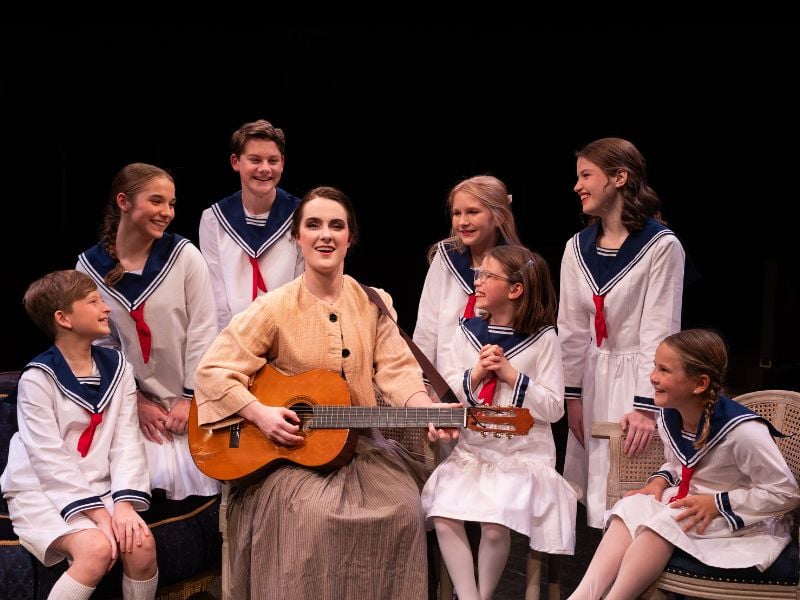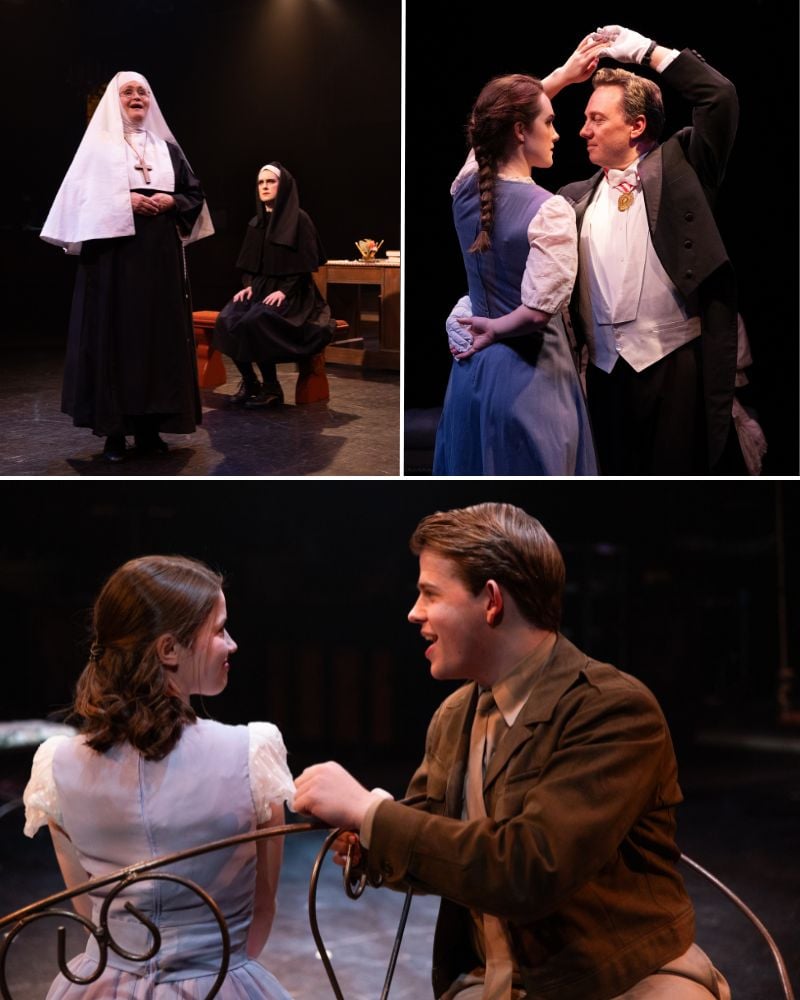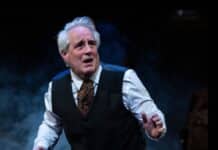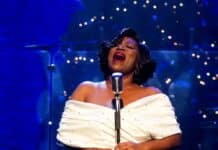It is hard to imagine, especially at this time of year, that anyone hasn’t seen the beloved 1965 movie version of Rodgers and Hammerstein’s The Sound of Music, which opens with the iconic helicopter shot of Julie Andrews spinning in an Alpine meadow. It is a holiday staple.
Far fewer people saw the original Broadway production, even though it won five Tony awards, including Best Musical in 1959, and ran for 1,443 performances over four years — that was still half a year short of just the original theatrical release of the movie. So it is understandable that many people will arrive at a revival of the stage version with an indelible imprint of picnics in the mountains, Salzburg montages, and that marionette show engraved on their minds.

For that reason, it is worth examining the places where the movie departed from the show — so that it doesn’t feel like the other way around. Both were based on the memoir of the actual Maria von Trapp, detailing how she escaped from Austria with her Naval Captain husband and their children when the Nazis invaded in 1938. Maria, teaching at an Abbey and intending to become a nun, was asked to come tutor the Captain’s daughter and then began caring for all of the children. Seeing how much she loved the children, Georg von Trapp asked her to marry him, even though he was 25 years her senior. She fled back to the Abbey to seek advice, and the mother Abbess — rather than telling her to follow her heart, as in the musical — told her it was God’s will that she marry him, which she did in 1922. She originally said she was angry, because she really wanted to be a nun, but she loved the children enough that she decided to accept his offer. She came to love her husband deeply, and they had three children of their own, in addition to the seven stepchildren. The drama of their flight from Austria was greatly heightened for the show; in reality, long-married before the events in the show take place, they were touring as a musical act to try to recover from Captain von Trapp’s losing his fortune in 1929 when they witnessed the increasing prejudice and cruelty as the Nazis seized power in Austria. When von Trapp was “offered” a commission in the German Navy, they left by train for Italy, then England and the United States. It is obviously much more dramatic to have them sneak away following their honeymoon after their first performance as the Trapp Family Singers, evade the Nazis, and then climb over the mountains to Austria.
The major departures the movie makes from the stage musical are in the order of the songs and the elaborateness of the staging. For instance, “My Favorite Things” is sung early in the show by Maria and the Mother Abbess to bolster Maria’s spirits on leaving the Abbey. (“I Have Confidence,” which serves that purpose in the movie, was written by Rodgers for the movie after Hammerstein died and does not usually appear in the stage version.) The song Maria uses to distract the children during the thunderstorm is “The Lonely Goatherd” — and no, there are no puppets in sight. Something in the stage show that may come as a pleasant surprise to moviegoers are two songs sung by the Captain, his fiancée Elsa, and his moocher friend Max — “How Will Love Survive” and “No Way to Stop It.” The first is about how unromantic it is that Elsa and the Captain are both rich and have no hardships to overcome (whereas in reality, the Captain was bankrupted by the Depression and there was no wealthy fiancée), and the second is a breezy hymn to capitulation for political self-preservation that the Captain abhors. These songs were left out of the movie, presumably for length, because Eleanor Parker, who played Elsa, apparently had a strong soprano voice. One song from the movie that has made it into revivals is “Something Good,” the love song that Maria sings to the Captain in place of the more pedestrian “An Ordinary Couple.”
Now that any unrealistic cinematic expectations have been gently disabused, viewers can thoroughly enjoy Toby’s Dinner Theatre’s production of The Sound of Music, a worthwhile holiday treat. While there are no breathtaking mountain vistas or soaring abbeys, the production team (David A. Hopkins’s scenic design, Lynn Joslin’s lighting, and Mark Smedley’s sound) make the best of Toby’s interesting in-the-round space. One staircase up to a backdrop stands in for the famous hills that are alive, and another, carpeted, wallpapered, and lushly curtained, capably indicates the upstairs of the von Trapp villa. Lovely stained-glass windows in the corners light up in the abbey scenes as gothic lanterns descend from the ceiling. These alternate with a charming swing for “Sixteen Going on Seventeen” and chandeliers for ballroom scenes, making it all the more shocking when red banners with swastikas descend for the final concert, to be violently torn away by brownshirts as the chase scene begins (a dramatic way to get them offstage for the next scene).

In fact, overall, Director and Choreographer Mark Minnick makes excellent use of the limitations of the space. Scene changes are covered by carefully lit business on one of the staircases or exits while a crack team of ninja stagehands hustle furniture in and out in the dark. Minnick also expertly handles the careful choreography required to manage the sightlines and allow everyone in the audience to be able to see all the actors’ faces at some point in every scene. In Rolf and Liesl’s scene in the garden, the staging makes good use of a “conversation sofa” where the characters can face two different directions. In a number like “So Long, Farewell,” which is much easier to stage in a straight line, the children face different directions to say goodbye to all of the guests at the ball (and the audience). All in all, seeing the clever ways Minnick deploys his set pieces and actors in the space is enthralling enough that one doesn’t miss all the Salzburg scenery.
Janine Sunday and Sarah King’s costumes are entirely appropriate. From the nun’s habits to Maria’s cast-off dress (“the poor didn’t want this one”), to the children’s charmingly awful outfits made from curtains, to Elsa Shrader’s glamorous gowns, to Maria’s suit when she returns from her honeymoon that is just tight enough to suggest that she’s (ahem) a woman now, they fit the bill admirably.
The small six-piece band, led from the keyboard by Music Director Ross Scott Rawlings and hidden behind a stained-glass window above the audience, sounds larger than it is but never overwhelms the voices.
And those voices are the highlight of the evening. The nun’s chorus, which sounds much larger than it is, is suitably sublime in the “Preludium” that serves in place of an Overture (although at one point in the “Gaudeamus Domino” before the wedding, the balance seems tipped towar the sopranos). Max (David James) is agreeably smarmy and conniving. Asia-Ligé Arnold’s Elsa Shraeder makes a glamorous and worldly rival for Maria, although her vibrato is so pronounced that at times it interferes with both her pitch and her diction. But it is satisfying that she realizes that she and the Captain are misaligned morally, rather than saccharinely sacrificing her own love for Maria’s greater one, as she does in the movie. The von Trapp children sing like angels and act just slightly like devils, just as they should. Emily Signor’s Liesl is particularly strong. And Friedrich’s (Owen Kulikowski, Jackson Paige, or Lucas Rahaim) hitting the high G “money note” in “So Long, Farewell” is a treat. The Mother Abbess (Adrienne Athenas) has the daunting task of ending not only Act 1 but the entire show with “Climb Ev’ry Mountain,” and at the performance we saw, there was some question at the beginning as to whether she could rise to the moment, as it were — but when the time comes she hits the high notes strongly as an abbey bell.
Of course, the linchpins of the show are the Captain and Maria. When Christopher Plummer was offered the role in the movie, he refused until he was assured he could work with the director to make the character more interesting. Unfortunately, that option is not available to the actor in the stage musical. Also, there is the somewhat uncomfortable (for modern audiences) issue of the Captain being so much older than Maria and her employer to boot. But since the story is based on real events and set very firmly in its era (both 1938 and the early 60s), we need to calm our qualms and take the relationship as written. Jeffrey Shankle makes a suitable Georg von Trapp — stiff, proper, humorously grumpy, and rigid at the beginning, rightly angry at what the Nazis are doing to his beloved Austria, and loving towards the children and Maria under her influence. Shankle’s voice is warm and strong in “Edelweiss.” It is not an overwhelming performance, but everything the role gives him he does well.
Rachel Cahoon’s Maria is perhaps the most different from the one presented in the film. Whereas in the movie, the moments where Maria gives back the Captain’s whistle and later says, “I’m not finished yet!” to make him listen come across as shocking, here they seem totally expected. The line the nuns sing about her being “a will-o-the-wisp” in “Maria” has never seemed so mistaken. This Maria is a force to be reckoned with, something like her beloved mountain. Calhoon has fierce eyebrows and a strong voice that chase away any hint of sugary sweetness that has previously cloyed the character. And this also helps to clear any remnants of unease about the Captain and Maria’s relationship. They are clearly equals from the beginning.
All in all, this Sound of Music is a charming, interesting, and delightful production.
This is the point where a reviewer usually says, “Grab a ticket and go!” but Toby’s production of The Sound of Music has been sold out since before it opened. So here’s hoping this review has given you a taste of the pleasures of the show, and how it can be enjoyed in its own right, not just as a pale precursor to the film.
And if you have tickets, and haven’t been there before, be sure to check out all the fiber art pieces hanging in the lobby, representing past shows.
You can try calling the box office at 410-730-8311 to see if any seats have opened up, and it looks like some tickets to Toby’s New Year’s Eve extravaganza are still available.
Running Time: Approximately two hours and a half hours with one intermission.
The Sound of Music plays through January 12, 2025, at Toby’s Dinner Theatre, 5900 Symphony Woods Road, Columbia, MD. Tickets, including dinner and show (adult, $74–$92; child, $64–$67), can be purchased by calling 410-730-8311 or online.



